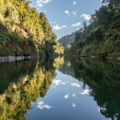Wild Law: Giving Nature A Legal Voice
Holly W.R. | February 5, 2015.
We have long relied on traditional governance methods to guard against the loss of critical habitats and species. National parks, World Heritage listing and legislation protecting threatened fauna and flora have all been significant and important means of protection. However, it is clear that they are struggling to meet and prevent the scale of damage occurring around the world.
It’s not that these methods are failing in themselves – the problem lies directly with the legal systems underpinning them.
The traditional role of legal protection
From its early inception in common law, legal protection of the environment has steadily grown in breadth and scope. Due to early limitations on private landholders, governments have gradually become more proactive at local, state and international levels in introducing legislation and treaties to conserve natural systems.
This body of ‘environmental law’ has been functional. Domestic laws often impose criminal penalties, ensuring individuals and corporations can be punished for and deterred from environmentally harmful behaviours. International treaties are enforced at a domestic level to protect landscapes or species of global importance. Some laws have also begun to incorporate high-level sustainability concepts, such as the precautionary principle, to guide overall decision-making.
However, to say that the law is functional does not mean that it is successful.
The problem with law
The fact is that on the ground, environmental degradation continues relatively unabated.
Interestingly, the most recent IUCN World Heritage outlook report states that “the legal framework and enforcement is the management aspect that is most frequently of serious concern” at sites under threat.
Conventional environmental regulation, while useful, doesn’t seem to be enough. What’s missing?
“Environmental regulation assumes environmental degradation.”
The problem with the law’s treatment of the environment is that it focuses on means, not ends.
Environmental laws most often allow development to proceed with conditions, or punish obvious harm committed in isolated incidents.
However, they rarely establish an agreed, overarching environmental threshold that cannot be crossed.
‘Wild law’: a rights-based approach
Wild law is a concept that seeks to set a baseline standard for how the environment should be treated. Effectively, it asserts that nature is a rights-bearing entity in its own right.
This concept may initially appear to be radical or unworkable. However, three things are clear:
First, even the most robust environmental laws have not succeeded in overall environmental protection. Preventing isolated incidents of damage, or relying on unenforceable global agreements, is no longer enough.
Second, legal rights have been extended before. This is not a revolutionary concept. As Christopher Stone recognised, in Should Trees Have Standing:
“Throughout legal history, each successive extension of rights to some new entity has been… a bit unthinkable. [Until the new entity is given rights] we cannot see it as anything but a thing for the use of us – those who are holding rights at the time.”
Lastly, and most importantly, wild law is already being put into practice. The next part of this series will explore how conventional legal parameters are being challenged around the world. It will demonstrate that shifting the legal system to give environmental protection proper force is not only a necessary but an entirely viable reform.
The question is, are we ready to set a true baseline standard for the quality of the natural systems in which we exist?













comment